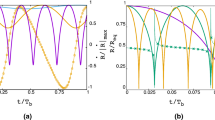Abstract
An important aspect of the processes of cavitation and boiling is the concept of a nucleus that acts as a preferential site for the inception of these events. It is commonly thought that except for rare instances or specially controlled experiments, all cavitation and boiling sites originate at the location of such a nucleus. In order to study these important phenomena, then, it is imperative that as much as possible be known about nucleation in cavitation and boiling. It is generally accepted that free air bubbles normally do not act as nucleation sites because they are inherently unstable to dissolution due to surface tension. Thus, the study of nucleation is necessarily associated with mechanisms for stabilizing microbubbles or pockets of gas within the liquid. In this paper, various stabilization models that have been proposed are reviewed as well as the experimental evidence that supports the specific models. One particular model, the crevice model, is examined in some detail, and its predictions are used to explain several different measurements of boiling and cavitation inception. Finally, some evidence that has recently become available concerning the damaging aspects of high intensity ultrasound is examined. Many aspects of this evidence point to the existence of cavitation as the damage mechanism. Also given in this paper are preliminary explanations of these effects due to the growth of microbubbles or cavitation nuclei by rectified diffusion.
Similar content being viewed by others
References
Akulichev VA (1966) Hydration of ions and the cavitation resistance of water. Sov Phys Acoustics 12: 144–149.
Alty T (1926) The origin of the electrical charge on small particles in water. Proc Roy Soc, Ser A. 112: 235–251.
Apfel RE (1970) The role of impurities in cavitation threshold determination. J Acoust Soc Amer 48: 1179–1189.
Apfel RE (1970) A novel technique for measuring the strength of liquids. J Acoust Soc Amer 49: 145–155.
Bargeman D and Van Voorst Vader F (1973) Effect of surfactants on contact angles at nonpolar solids. J Coll Inter Sci 42: 467–472.
Child SZ, Carstensen EL and Miller MW (1975) Growth of pea roots exposed to pulsed ultrasound. J Acoust Soc Amer 58: 1109–1110.
Child SZ, Carstensen EL and Lam SK (1981) Effects of Ultrasound on Drosophilia: III. Exposure of larvae to low-temporal average-intensity, pulsed irradiation. Ultrasound in Med and Biol 7: 167–173.
Crum LA (1979) Tensile strength of water. Nature 278: 148–149.
Crum LA (1980) Acoustic cavitation thresholds in water. In Lauterborn W (ed) Cavitation and Inhomogeneities in Underwater Acoustics. New York: Springer-Verlag.
Crum LA (1980) Measurements of the growth of air bubbles by rectified diffusion. J Acoust Soc Amer 68: 203–211.
Eller AI and Flynn HG (1965) Rectified diffusion during nonlinear pulsations of cavitation bubbles. J Acoust Soc Amer 38: 493–503.
Ellis AT, Waugh JG and Ting RY (1970) Cavitation suppression and stress effects in high-speed flows of water with dilute macromolecule additives. J Basic Engr Trans ASME 92: 459–466.
Epstein PS and Plesset MS (1950) On the stability of gas bubbles in liquid-gas solutions. J Chem Phys 18: 1505–1509.
Flynn HG (1964) Physics of acoustic cavitation in liquids. In Mason WP (ed) Physical Acoustics, Vol. I, Part B. New York: Academic.
Fox FE and Herzfeld KF (1954) Gas bubbles with organic skin as cavitation nuclei. J Acoust Soc Amer 26: 985–989.
Greenspan M and Tschiegg CE (1967) Radiation-induced cavitation; apparatus and some results. J Res Nat Bur Stds 71C: 299–312.
ter Haar G and Daniels S (1981) Evidence for ultrasonically induced cavitation in vivo. Physics in Med and Biol 26: 1145–1149.
Harvey EN, Barnes KK, McElroy WD, Whitely AH, Pease DC and Cooper KW (1944) Bubble Formation in Animals, I. Physical Factors. J Cell Comp Physiol 24: 1–22.
Herzfeld KF (1957) Comment. In Sherman FS (ed) Proc First Sympos Naval Hydrodynamics (Nat Acad Sci Wash DC) pp 319–320.
Hoyt JW (1976) Effect of polymer additives on jet cavitation. J Fluids Engr 98: 106–112.
Hsieh DH and Plesset MS (1961) Theory of rectified diffusion of mass into gas bubbles. J Acoust Soc Amer 33: 206–215.
Morris JW and Coakley WT (1980) The nonthermal inhibition of growth and the detection of acoustic emissions from bean roots exposed to 1 MHz ultrasound. Ultrasound in Med and Biol 6: 113–118.
Neppiras EA and Coakley WT (1970) Acoustic cavitation in a focused field in water at 1 MHz. J Sound Vib 45: 341–373.
Sirotyuk MG (1970) Stabilization of gas bubbles in water. Sov Phys Acoustics 16: 237–240.
Sirotyuk MG (1971) Experimental investigations of ultrasonic cavitation. In Rozenberg LD (ed) High Intensity Ultrasonic Fields. New York: Plenum.
Sirotyuk MG (1971) Elasticity and strength of stable gas bubbles in water. Sov Phys Acoustics 16: 482–484.
Strasberg M (1959) Onset of ultrasonic cavitation in tap water. J Acoust Soc Amer 31: 163–176.
Winterton RHS (1977) Nucleation of boiling and cavitation. J Phys D: Appl Phys 10: 2041–2056.
Yount DE, Hunkle TD, D'Arrigo JS, Ingle FW, Yeung CM and Beckman EL (1977) Stabilization of gas cavitation nuclei by surface-active compounds. Av Sp Env Med 48: 185–191.
Yount DE (1978) Skins of varying permeability: a stabilization mechanism for gas cavitation nuclei. J Acoust Soc Amer 65: 1429–1439.
Author information
Authors and Affiliations
Rights and permissions
About this article
Cite this article
Crum, L.A. Nucleation and stabilization of microbubbles in liquids. Applied Scientific Research 38, 101–115 (1982). https://doi.org/10.1007/BF00385941
Issue Date:
DOI: https://doi.org/10.1007/BF00385941




